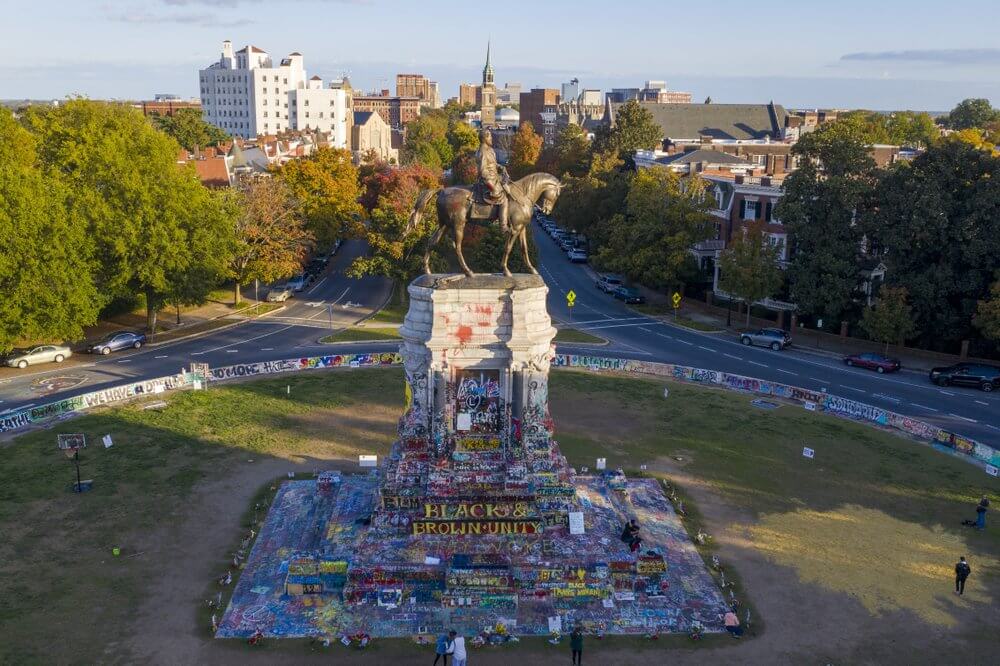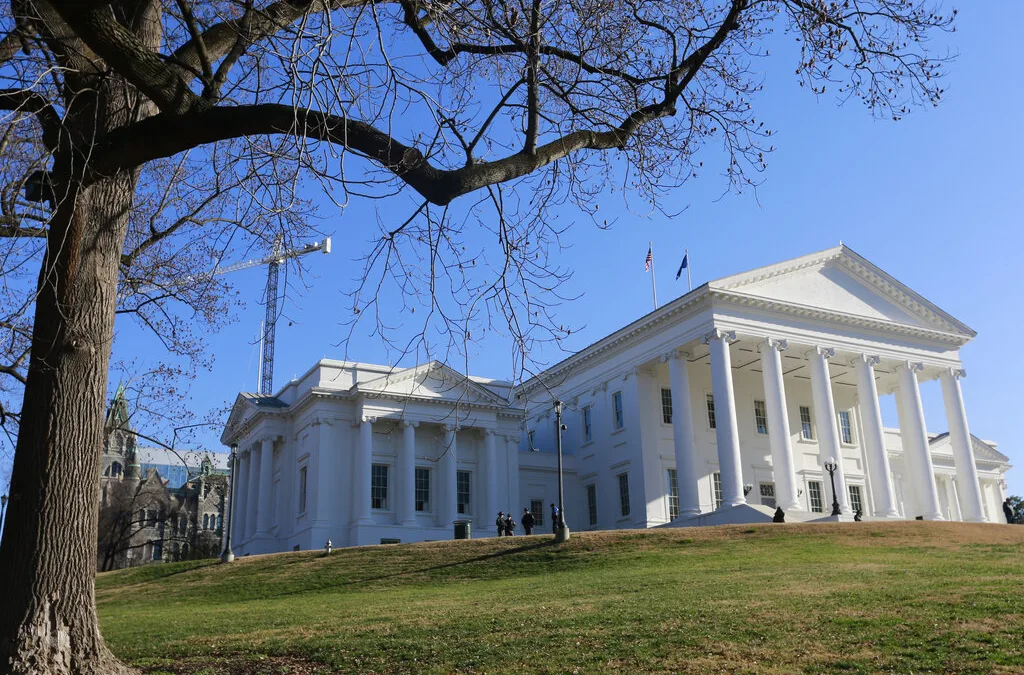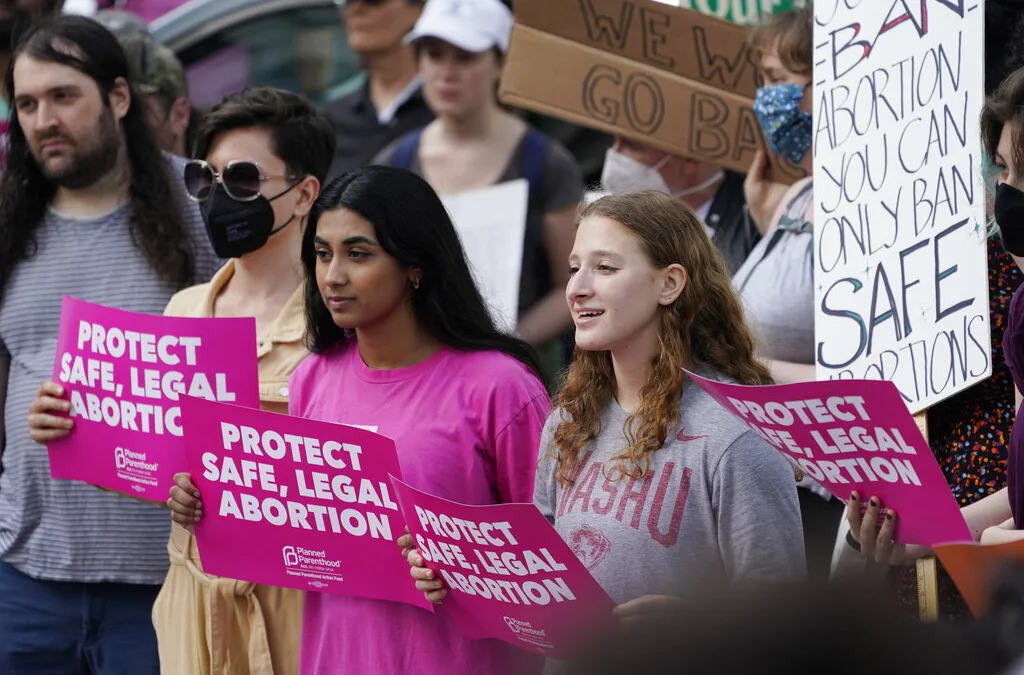
The afternoon sun illuminates the statue of Confederate General Robert E. Lee on Monument Ave in Richmond, Va., Monday, Oct. 19, 2020.
Judge puts ruling on hold, however, until the appeal plays out.
RICHMOND-Governor Ralph Northam has the authority to remove a statue of Robert E. Lee in the capital city. Richmond Circuit Court Judge W. Reilly Marchant issued that ruling Tuesday, rejecting a lawsuit brought by several city residents.
The issue here involves a bronze statue of Lee on Monument Avenue, one standing 21-feet-high and weighing 12 tons. According to state records, this is the last and the largest monument of its kind in Virginia. And one at the center of a legal battle now stretching into its fifth month.
In June, Northam labeled the statue as a racist symbol and ordered the Virginia Department of General Services to take it down. In response, several residents filed a lawsuit, attempting to stop the memorial’s removal. They pointed out the federal government designates Monument Avenue and the surrounding area as a National Historic Landmark District. Without the statue, the group argued, they were afraid the status would be removed. That means each homeowner could lose “favorable tax treatment” and see property values drop.
Here’s where the legal argument came into play. The Monument Avenue residents argued Northam didn’t legally have the power to remove the statue. Doing that, they claim, would violate the agreement reached 131 years ago. When the General Assembly accepted transfer of property in 1889, they agreed to several restrictive covenants in the deeds, the group’s attorneys argue.
READ MORE: 11 Confederate Statues Are Coming Down in Richmond. Here’s What You Need to Know.
You can’t enforce the covenant
Marchant agreed that the 1890 deed and the other documents were in fact restrictive covenants. The issue, he said, is that it doesn’t matter.
“The Virginia Supreme Court has long held that in order to enforce deed restrictive covenants, such enforcement must not be contrary to public policy,” he wrote. “Nor should conditions have so radically changed as to practically destroy the original purposes of the covenant.”
The Virginia Supreme Court and Virginia Court of Appeals have long said it’s the General Assembly, not the court system, that determines public policy, Marchant added. And, he pointed out, they made public policy very clear on this issue during this fall’s special session. That’s when they passed House Bill 5005 and Senate Bill 5015. Halfway through those budget bills, there’s a specific line making it clear what lawmakers want done with the statue.
“The Department of General Services, in accordance with the direction and instruction of the Governor, shall remove and store the Robert E. Lee Monument or any part thereof,” the bills say.
The bills also repeal the Joint Resolution from 1889, which gave then-governor Phillip McKinney authority to accept the deed from the Lee Monument Association.
“These acts of the General Assembly clearly indicate the current public policy of the General Assembly, and therefore the Commonwealth, to remove the Lee Monument from its current position on the state owned property on Monument Avenue,” Marchant wrote.
The lawsuit argued since these budget bills were approved in a special session, they’re unconstitutional and should be ignored. But the court can’t find any evidence to back that up, Marchant said.
What about Richmond’s commission?
Marchant also referred to the Monument Avenue Commission on the Removal of Confederate Statues. Richmond city officials created the project for the purpose of determining what to do with all Confederate statues in the area. The group held public forums, went through almost 2,000 letters and conducted research. In the end, they recommended removing the Jefferson Davis statue and keeping the others up, including the Lee monument. However, that was an advisory commission, Marchant said.
“The Commission does not establish public policy,” Marchant said. “The Commission’s recommendations would seem to reflect public opinion, public input and good faith deliberations by its highly qualified members [but] only the General Assembly establishes public policy for the Commonwealth.”
With that being the case, Marchant dissolved the temporary injunction against removing the monument. However, that doesn’t mean the Lee statue can be immediately removed. As the Monument Avenue group plans to appeal, Marchant suspended execution of his order. That means until the appeal is over, the statue can’t be taken down.
Virginia lawmakers said it was good to see the ruling.
“The Lee monument was built to celebrate the Confederacy and uphold white supremacy,” Gov. Northam said in a statement. “This victory moves Virginia forward in removing this relic of the past – one that was erected for all the wrong reasons.”
Richmond resident and Virginia State Senator Jennifer McClellan, who voted for the budget bills as part of this year’s special session, said she was also glad to see Marchant’s ruling.
“I have passed by the Lee Monument in my neighborhood countless times and winced at the trauma it represents for our community,” McClellan said. “Today, we are one step closer to lifting this burden off of the shoulders of the Black community in Virginia.”

VIDEO: Your support matters!
Your support matters! Donate today. @vadogwoodnews Your support matters! Visit our link in bio to donate today. #virginianews #virginia #community...

Op-Ed: Virginia’s new Democratic majorities pass key bills to improve your lives, but will Youngkin sign them?
The 2024 Virginia General Assembly regular session has wrapped up. It was a peculiar session from the outset, with Democratic majorities in the...

Op-Ed: Why Virginia Needs A Constitutional Amendment Protecting Reproductive Freedom
Virginia’s recent election season in 2023 drew in eyes from all over the country. Reproductive freedom was on the line and Virginia remained the...

From the state rock to the state flower, here’s how Virginia got its symbols
Have you ever wondered why the Dogwood is the state flower? Or how the cardinal became the state bird? We’re here to answer those questions and more...

VIDEO: Second-gentleman Douglas Emhoff gives speech on reproductive freedom
Second gentleman, Douglas Emhoff touched on reproductive freedom not only being a woman's issue but "an everyone's issue" during the Biden-Harris...

Glenn Youngkin and the terrible, horrible, no good, very bad night
Election Day 2023 has come and gone, and while there are votes to be counted, one thing is perfectly clear: Virginians unequivocally rejected Gov....




